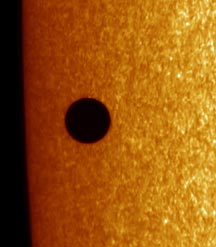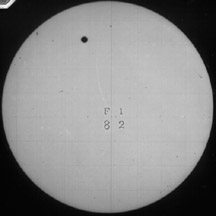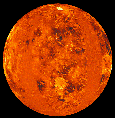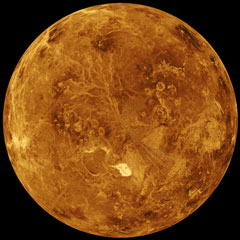This diagram shows a simulated view of the black disk of Venus against the backdrop of the Sun during the Venus transit of June 2004. The yellow arrows show the path of Venus across the face of the Sun throughout the course of the transit.
Click on image for full size
This illustration is original Windows to the Universe artwork created by Randy Russell. The image of the Sun is courtesy SOHO (ESA & NASA); information on the apparent size and path of Venus courtesy Fred Espenak, NASA's GSFC.
Transits of Venus
The planet Venus periodically passes directly between Earth and the Sun. This
event, which is somewhat similar to a solar
eclipse, is called a transit of
Venus. Viewed from Earth, Venus and Mercury are the only two planets that can
transit the Sun.
Transits of Venus are very rare events. The last Venus transit was in 1882.
The next one will be on June 8, 2004. Venus transits come in pairs separated
by eight years, with more than a century between successive pairs. The second
in the upcoming pair will be on June 6, 2012.
At least some part of the 2004 transit, which will last about six hours, will
be visible from most places on Earth. NASA
has a web site that provides information
about viewing this transit.
Transits of Venus played an important
role in the history of astronomy. Astronomers
in the 1700s and 1800s used measurements of angles during Venus transits
to determine the length of the Astronomical
Unit (AU), the distance from
Earth
to the Sun.
You might also be interested in:

A "transit" is the name of a type of astronomical event. A transit is similar to a solar eclipse, except a transit involves a planet, instead of the Moon, passing in front of the Sun. As viewed from Earth,
...more
The planet Mercury appeared to cross in front of the disk of the Sun on May 7, 2003. Astronomers call the event a transit. A transit is similar to a solar eclipse. However, a transit occurs when a planet,
...more
Transits of Venus are extremely rare astronomical phenomena. They occur in pairs, separated by eight years, with more than a century elapsing between successive pairs of transits. There will be two Venus
...more
A rare astronomical event will occur in early June 2004. For the first time since 1882, Earthlings will be able to view a transit of the planet Venus. "Transit" is a term used by astronomers when a planet
...more
The planet Mercury will cross in front of the disk of the Sun on Wednesday, November 8, 2006. Astronomers call the event a transit. A transit is similar to a solar eclipse. However, a transit occurs when
...more
Venus is the second planet from the Sun, and is Earth's neighbor in the solar system. Venus is the brightest object in the sky after the Sun and the Moon, and sometimes looks like a bright star in the
...more
The planet Venus periodically passes directly between Earth and the Sun. This event, which is somewhat similar to a solar eclipse, is called a transit of Venus. Viewed from Earth, Venus and Mercury are
...more
Would you expect to find ice caps and snow fields on Venus? Not likely! Venus is the hottest planet in our Solar System, and those high temperatures extend right on up to the poles. Though there aren't
...more











